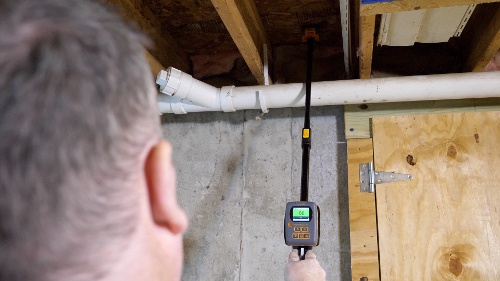The #1 Place to Take Water Damage Moisture Readings After a Flood
Chris Ranwell
Nov 3, 2021 8:00:00 AM

Be it a commercial space or a home, there’s nothing pretty about flood damage inside a building.
After a deluge of water, it’s not uncommon to find waterlogged drywall, soggy carpets, or ruined furniture and appliances strewn about a space.
And that’s just what you can see.
Whether caused by a burst pipe or a major weather event, it may seem like everywhere in a building’s impacted area is fair game for testing after a flood.
And that’s the truth.
Floods don’t discriminate with what they damage -- even the out-of-sight contents of a building are at risk. Regardless of how widespread or limited flood damage may appear in a building, everywhere should be tested for moisture.
Zeroing in on ‘Everywhere’ for Post-Flood Water Damage Moisture Readings
The primary goal of any post-flood water damage inspection isn’t to measure the flood-affected area and the amount of moisture present in a building’s materials. Rather, it’s to determine the range affected by moisture and establish how big the space is that needs to dry out. How do you do that? By checking everything.
A visual inspection is always the first part of this effort. There are the obvious things to check that are immediately apparent:
- Carpet
- Wood
- Drywall
- Ceilings
- Furnishings
But remember: The absence of evidence is not evidence of absence. Just because you can’t see water damage or moisture doesn’t mean it’s not present. Some spots are impossible to visually check for moisture after a flood, but should absolutely be part of a water damage restoration inspection:
- Sill plates
- Underneath flooring
- Behind baseboards
- Behind walls
Sill Plates
Quite literally a building’s anchor, sill plates (the pieces of wood affixed to the foundation) are one most important places to investigate for moisture presence after a flood.
Moisture damage to sill plates can spell trouble for the rest of a structure. Water-damaged sill plates may jeopardize a building’s structural integrity and safety, as moisture may cause them to:
- Split
- Rot
- Warp
Underneath Flooring
Certain flooring types -- linoleum, laminate, and tile -- may not show immediate signs of moisture damage. They may, however, act as a mask of sorts, covering water-damaged wood subflooring.
Over time, water-damaged subflooring may warp and buckle. And because it’s not exposed to sunlight, it’s a breeding ground for mold.
Baseboards
Installed where the floor and walls meet in a space, baseboards are a key indicator for moisture presence in other unseen spaces.
Most baseboards are wooden. As wood is a hygroscopic material, baseboards absorb and release moisture until they reach the same moisture level as the materials around them. High moisture readings in a baseboard require further investigation of the area around it.
Behind Walls
Like underneath flooring, cavities behind walls are impossible to see during a visual inspection. And also like flooring, some wall materials (tile, paneling, or brick) don’t make it obvious there’s a moisture issue behind them.
The dark voids between studs and insulation are also perfect habitats for mold and other bacteria to flourish. If undisturbed, a small mold issue behind a wall becomes a much larger one -- without the property owner knowing until it’s too late.
Tools to Help You Inspect Everywhere for Moisture Damage
Surveying for water damage and moisture everywhere inside a building should be a time-consuming and thorough process. A moisture survey after a flooding event is among the first steps of recovery for the property owner. As the saying goes, “Leave no stone unturned.”
Taking water damage moisture readings doesn’t have to be a tedious process. Professional-grade tools and equipment help streamline the process without sacrificing accuracy. At minimum, a restoration professional’s toolbox should be similar to that of a home inspector:
Pin-type meter: A device defined by its probes (pins), pin-type meters measure the moisture content of a material.
Pinless moisture meter: A restoration expert’s best friend when checking for moisture in areas out of sight, pinless moisture meters detect moisture’s presence within its depth of measurement. Its readings always require verification by a pin-type meter. Pinless moisture meters are ideal floor moisture meters.
Hygrometer: Made to measure relative humidity, a hygrometer’s readings give you a broad indication of moisture’s presence within a space. Higher readings = a greater chance that a room has a moisture issue.
Thermal Imaging Camera: While a thermal imager does not measure moisture, it does show temperature differences -- something the naked eye cannot see. Cooler spots may be moisture.
Key Accessories for Post-Flood Restoration Inspections
Whether you’re using a moisture meter for drywall or for flooring, accessories go a long way in completing a comprehensive inspection. You can upgrade the performance of a professional moisture meter with:
- Extension probes
- Baseboard moisture probes
- Heavy-duty hammer electrodes
- Deep wall probes
Taking a Holistic Approach for Water Damage Moisture Readings
Flood damage is almost never limited to just a small area inside a structure. When completing a moisture survey after a flood, there shouldn’t be a single area in a building that doesn’t get checked for water damage and lingering moisture -- especially the spots you can’t see.
Everything You’ll Need to Inspect Everywhere
Our Restoration Kit is your go-bag for showing up prepared to take water damage moisture readings:
